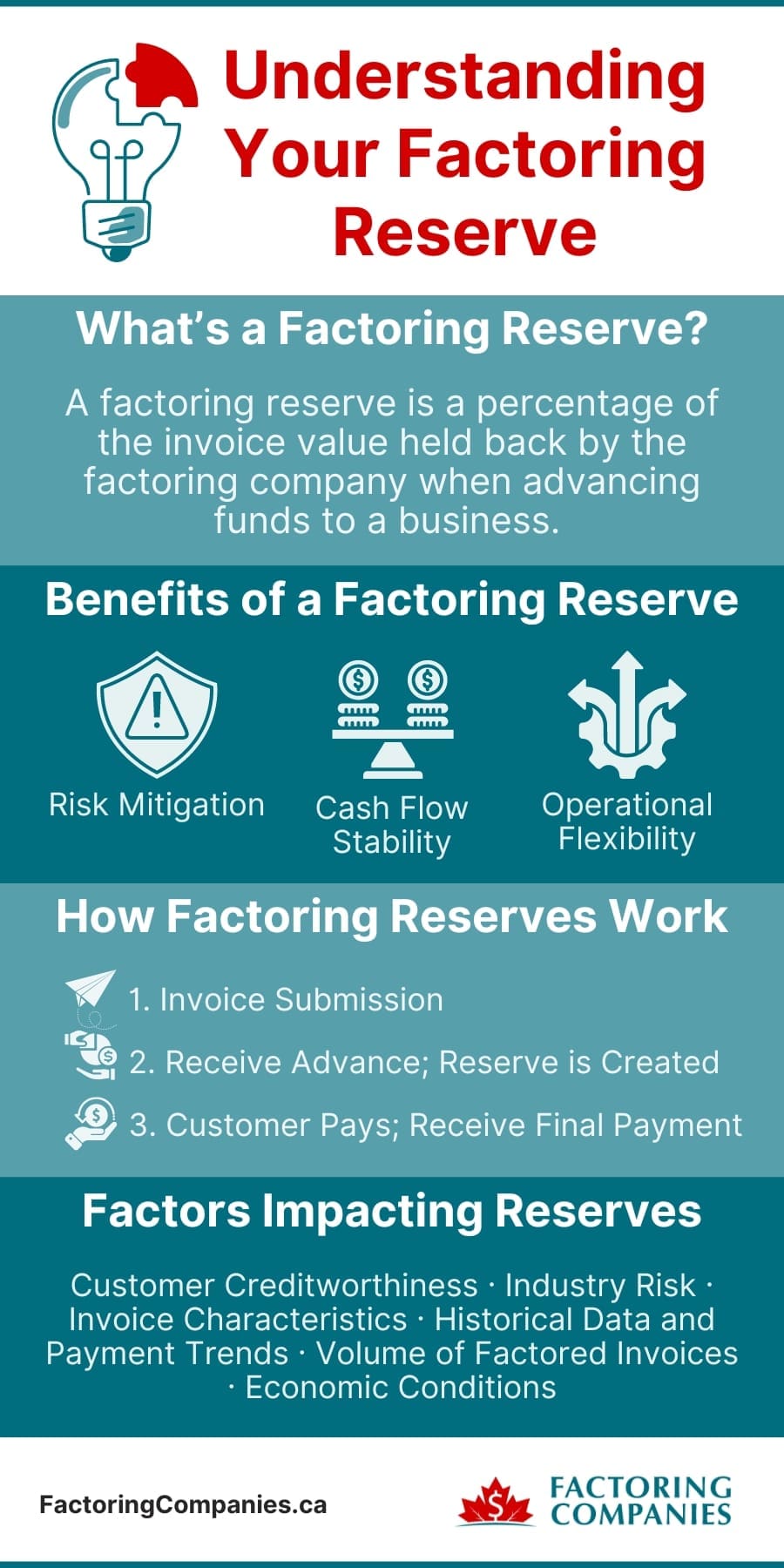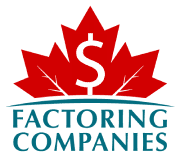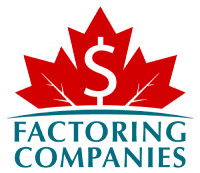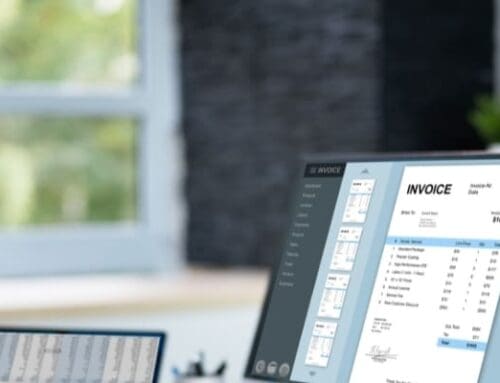
In the unpredictable world of business, one missed payment can derail your operations. But what if you had a financial cushion to absorb these shocks? Enter the factoring reserve, your business’s financial safety net. On this page, you’ll learn how factoring accelerates cash flow and provides financial stability, plus get details on the integral role reserves play in this process and what to expect when you’re factoring.
How Factoring Works
Invoice factoring is a financial service that helps businesses improve and safeguard cash flow by selling their accounts receivable, or invoices, to a factoring company at a discount. Instead of waiting for customers to pay, businesses receive immediate cash, which can be used to cover operational expenses, invest in growth, or manage other financial needs.
Factoring Benefits for Businesses
There are lots of benefits to factoring that go beyond receiving immediate cash.
- Easy Approval: Businesses can qualify for factoring even if they aren’t approved for traditional financing.
- No Debt: Factoring involves selling your invoices, so no debt is created on your balance sheet. This is an important distinction as many businesses are actively avoiding debt, and a quarter do not have the ability to take on debt, according to Statistics Canada.
- Enhanced Cash Flow Management: Factoring makes inflows more predictable, allowing the business to make smarter decisions on when and how to spend.
- Flexibility: Businesses can choose which invoices to factor and when to factor them. This makes it ideal for those with limited access to emergency funds and those who want a financial safeguard during economic downturns or business uncertainty.
The Factoring Process
The factoring process is straightforward. Although each company operates a little differently, most follow the steps outlined below.
- Invoice Submission: A business delivers goods or services to its customers and issues invoices.
- Selling Invoices: The business sells these invoices to a factoring company. Typically, the factoring company advances a percentage of the invoice value upfront—usually between 60 and 95 percent.
- Reserve Creation: The remaining percentage, known as the factoring reserve, is held back by the factoring company.
- Customer Payment: When the customer pays the invoice, the payment goes directly to the factoring company.
- Final Settlement: Once the factoring company receives the full payment from the customer, it releases the reserve amount to the business minus a factoring fee for the service provided.
The Factoring Reserve
The reserve acts as a factoring safety net. It mitigates the risk associated with non-payment or late payment of invoices. For the business, the reserve ensures that discrepancies or issues with the invoices can be managed without jeopardizing the entire cash advance received initially.
Factoring Process and Reserve Example
Let’s consider a small manufacturing business in Ontario. They produce custom furniture for several retail stores and issue an invoice of $100,000 with 30-day payment terms. Instead of waiting for a month, the business sells the invoice to a factoring company. The factoring company might advance $85,000 (85 percent of the invoice value) immediately.

The remaining $15,000 becomes the factoring reserve. When the retail store pays the full invoice amount after 30 days, the factoring company releases the reserve, deducting their fee (say 2 percent of the invoice value, or $2,000). The business receives the remaining $13,000 from the reserve.
By using invoice factoring, the business maintains a steady cash flow, enabling it to continue operations smoothly and invest in future projects without worrying about delayed payments.
How Your Factoring Reserve Acts as a Safety Net
The factoring reserve serves as a safety net in several ways, providing protection and flexibility for both the factoring company and the business. We’ll cover some key functions of the factoring reserve below.
Mitigating Credit Risk
The factoring reserve helps mitigate the risk of non-payment or late payment by the customer. Suppose a customer fails to pay the invoice on time or defaults entirely. In that case, the factoring company can use the reserve to cover the shortfall, reducing the financial risk involved in the transaction.
Addressing Invoice Discrepancies
In cases where there are discrepancies or disputes over the invoice amount, such as errors, returns, or service issues, the reserve can be used to settle these differences. This ensures that the factoring company isn’t left exposed to potential financial losses while allowing time to resolve the issue.
Adjusting for Volume and Industry Risks
Different industries and businesses have varying levels of risk associated with their receivables. For example, a business in a high-risk industry or with less creditworthy customers may have a higher reserve percentage. This adjustment helps the factoring company manage the inherent risks more effectively.
Providing Operational Flexibility
For businesses, having a reserve ensures that they receive the bulk of their invoice value upfront while retaining a buffer to address any potential issues. This flexibility can be crucial for maintaining smooth operations, as businesses can rely on consistent cash flow while managing any unforeseen circumstances that may arise with their receivables.
How Your Factoring Reserve is Determined
The determination of a factoring reserve involves assessing several factors to balance risk and provide adequate protection for the factoring company while offering fair terms to the business. Below, we’ll cover some of the key factors considered when determining the factoring reserve.
Creditworthiness of the Customers
One of the primary factors is the creditworthiness of the customers whose invoices are being factored. If the customers have strong credit ratings and a history of timely payments, the reserve might be lower. Conversely, if customers have weaker credit or a history of late payments, the reserve will likely be higher to mitigate the increased risk.
Industry Risk
Different industries have varying levels of risk associated with their receivables. For example, industries with longer payment cycles or higher rates of invoice disputes, such as construction or healthcare, may require higher reserves. The factoring company evaluates industry-specific risks to determine an appropriate reserve level.
Invoice Characteristics
The nature of the invoices themselves also plays a role. Factors such as invoice size, payment terms, and the consistency of invoice amounts can influence the reserve. Large invoices or those with longer payment terms might necessitate a higher reserve due to the increased exposure and time risk.
Historical Data and Payment Trends
The factoring company will review the business’s historical data, including payment trends and past-due invoices. A business with a strong track record of timely payments and minimal disputes may benefit from a lower reserve percentage, while those with inconsistent payment histories might see higher reserves.
Volume of Factored Invoices
The volume of invoices being factored can also impact the reserve. Businesses that factor a high volume of invoices regularly may negotiate more favourable reserve terms due to the ongoing relationship and lower perceived risk over time.
Economic Conditions
Broader economic conditions can also influence reserve levels. In uncertain economic times, factoring companies might adopt more conservative reserve policies to protect against potential increases in defaults or payment delays.
Find Out Your Factoring Reserve and Advance Rates
Factoring reserves represent a small portion of an invoice’s value but play an integral role in providing your business with the cash flow it needs. To find out how factoring might fit into your overall business strategy, request a complimentary rate quote.

Factoring Reserve FAQs
What is a factoring reserve?
A factoring reserve is a percentage of the invoice value held back by the factoring company when advancing funds to a business. It acts as a safety net to cover potential risks such as non-payment or invoice disputes. Once the customer pays the invoice, the reserve, minus fees, is released to the business.
How does a factoring reserve work?
When a business sells its invoices to a factoring company, it receives an advance (typically 70 to 90 percent of the invoice value). The remaining percentage, known as the factoring reserve, is held back. Once the customer pays the invoice, the reserve is released to the business after deducting the factoring fee.
Why do factoring companies hold a reserve?
Factoring companies hold a reserve to mitigate risks associated with non-payment, late payments, or invoice disputes. The reserve acts as a buffer, ensuring that the factoring company can recover any potential losses. This practice is essential for safeguarding business finance and maintaining trust between the factoring company and the business.
How is the factoring reserve percentage determined?
The factoring reserve percentage is determined based on factors like customer creditworthiness, industry risk, invoice characteristics, and the business’s payment history. Generally, it ranges from five to 40 percent of the invoice value. Higher-risk factors result in a higher reserve percentage to protect both the factoring company and the business.
What factors influence the amount of a factoring reserve?
Several factors influence the factoring reserve amount, including customer credit ratings, industry risk levels, invoice size and terms, historical payment trends, and overall economic conditions. These factors help the factoring company assess the potential risk and set an appropriate reserve to protect small business assets and ensure financial stability.
Can the factoring reserve be adjusted over time?
Yes, the factoring reserve can be adjusted over time based on the business’s performance and its relationship with the factoring company. As trust and positive payment history are established, the factoring company may reduce the reserve percentage, providing the business with greater cash flow flexibility.
What happens to the factoring reserve if an invoice is not paid?
If an invoice is not paid, the factoring reserve is used to cover the unpaid amount. This minimizes the financial impact on the factoring company. In such cases, the business may need to reimburse the factoring company for any shortfall, reinforcing the importance of safeguarding business finance through careful management of receivables.
Are there ways to reduce the factoring reserve?
Businesses can reduce the factoring reserve by improving customer creditworthiness, maintaining consistent and timely payment histories, and operating in lower-risk industries. Building a strong relationship with the factoring company and demonstrating financial stability can also lead to more favourable reserve terms.
How does the factoring reserve impact cash flow?
The factoring reserve temporarily holds back a portion of the invoice value, which can affect immediate cash flow. However, it also provides a safety net, ensuring businesses have funds available once the invoice is paid. This practice helps with managing financial risks and protecting small business assets, ultimately supporting long-term cash flow stability.
What is the typical range for factoring reserve percentages?
The typical range for factoring reserve percentages is between five and 40 percent, depending on various risk factors. Businesses with higher-risk profiles may see higher reserve percentages, while those with strong credit histories and lower-risk industries may benefit from lower reserves. This range helps in safeguarding business finance while providing necessary liquidity.

About Factoring Companies Canada
Related Articles
Get an instant factoring estimate
Factoring results estimation is based on the total dollar value of your invoices.
The actual rates may differ.
CLAIM YOUR FREE FACTORING QUOTE TODAY!
PREFER TO TALK?
You can reach us at
1-866-477-1778
Get an instant factoring estimate
Factoring results estimation is based on the total dollar value of your invoices.
The actual rates may differ.
CLAIM YOUR FREE FACTORING QUOTE TODAY!
PREFER TO TALK? You can reach us at 1-866-477-1778









